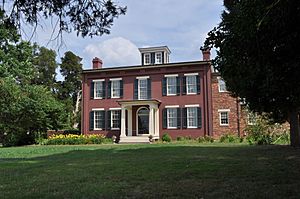Chippokes Plantation State Park facts for kids
Quick facts for kids Chippokes Plantation State Park |
|
|---|---|

House at Chippokes Plantation
|
|
| Lua error in Module:Location_map at line 420: attempt to index field 'wikibase' (a nil value). | |
| Location | Surry County, Virginia |
| Nearest city | Newport News |
| Area | 1,947 acres (787.9 ha) |
| Administered by | Virginia Department of Conservation and Recreation |
|
Chippokes Plantation
|
|
| Area | 1,403 acres (567.8 ha) |
| Built | 1829 |
| Architectural style | Italianate |
| NRHP reference No. | 69000283 |
| Significant dates | |
| Added to NRHP | October 01, 1969 |
Chippokes Plantation State Park is a special place in Surry, Virginia. It sits right by the James River and Route 10. This park is in a farming area of Surry County. It is protected as a state park.
Chippokes is famous for being one of the oldest farms in North America. It has been farmed continuously for over 400 years! Today, it's a fun place to visit. You can learn about history, enjoy nature, and do outdoor activities.
Contents
Exploring Chippokes Plantation's Past
Chippokes Plantation got its name from Choapoke. He was a leader, called a weroance, of the Quiyoughcohannock people. These people were part of the Powhatan Paramount Chiefdom. Their lands were between two creeks. They were successful farmers and traders. By 1619, their lands became part of the English colony.
Early Owners and Changes
In 1619, Captain William Powell received the land for Chippokes. He was an "Ancient Planter." This meant he had lived at the Jamestown settlement for 10 years. After Powell died, the land passed to his baby son, George. Later, Governor William Berkeley bought the plantation. When he died, his wife, Lady Frances Culpeper Berkeley, took over. She then married Philip Ludwell I.
The Ludwell family owned Chippokes Plantation for almost 150 years. One famous owner was Philip Ludwell III. He was the first known Orthodox Christian in America. His daughter, Lucy Ludwell Paradise, was friends with Thomas Jefferson.
Life at the Plantation
In 1837, Albert Carroll Jones became the first owner to live at Chippokes. Before him, owners lived elsewhere. Enslaved workers and paid overseers lived on the property. Albert Jones built a grand house called the Jones-Stewart Mansion. Before the Civil War, 47 enslaved people lived at Chippokes. Their forced labor helped the farm produce crops and brandy. Some enslaved individuals stayed on the property after the war ended.
Becoming a State Park
In 1918, Victor Stewart and Thornton Jeffress bought Chippokes. They planned to cut down the trees. But Victor and his wife, Evelyn, decided to live there instead. They fixed up the old mansion and gardens. The Stewarts had no children. So, they decided to give Chippokes Plantation to the Commonwealth of Virginia. They wanted it to become a park for everyone to enjoy. Chippokes Plantation State Park opened in 1970.
Today, Chippokes is still a working farm. It offers many fun things to do. You can find modern facilities, a swimming pool, and trails. There are also camping spots and cabins to rent. Park rangers lead tours of the historic house. They also offer guided hikes and craft workshops. The park is also known for its riverfront. You can find many ancient marine fossils there.
Chippokes Farm & Forestry Museum
The Chippokes Farm and Forestry Museum opened in 1990. It's an open-air farm museum. This means you can walk around and see buildings outdoors. The museum has five buildings. They show what life was like for farmers in Tidewater Virginia. You can see how people lived from 1619 to 1950.
The museum has old farmhouse rooms and workshops. It also shows traditional farm tools. You can learn about the role of forestry (working with trees) in the area. The museum also has live exhibits. These include special farm animals and a Cultural Garden. They help tell the story of Chippokes Plantation's 400-year history. You can visit the museum from March to December.
Walnut Valley Plantation
In 2004, Walnut Valley Plantation became part of Chippokes Plantation State Park. This plantation was started in 1636. It is 550 acres and sits next to Chippokes. It has the oldest plantation house in the park. The Walnut Valley House was built around 1770. There is also a restored slave quarter from 1816. This is one of the oldest remaining in Virginia. Today, the old house can be rented as a quiet lodge.

